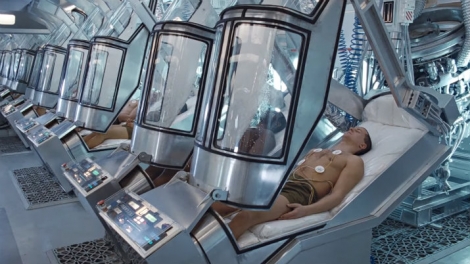Suspended Animation is defined as is an extreme slowing, or even stopping of the physiological processes of a living creature for a period of time and then fully resuscitating that creature back to its normal life. During suspended animation the heartbeat, breathing, even the metabolic processes of individual cells are slowed if not halted entirely.

Also commonly known as hibernation, in nature suspended animation is used by many creatures to ‘sleep’ their way through periods of scarce resources. The classic example is of course that of bears hibernating through the winter when there is little food for them to eat but there are also creatures who suspend their life processes during times of drought or extreme heat.

In science fiction suspended animation has played a key role in many SF stories, novels and movies. In those stories suspended animation allows human beings to undertake long space missions without expending the resources, food, water and air that such long voyages would otherwise require. Some of the most famous SF stories employ suspended animation for this purpose including ‘2001: A Space Odyssey’, ‘Alien’, the ‘Space Seed’ episode of the original Star Trek, I could go on and on.


And make no mistake NASA is keenly interested in the possibilities that suspended animation could bring to their goal of exploring space. Problem is however, unlike bears human beings don’t hibernate, even when we sleep our metabolism hardly changes from its normal rate.
Medical doctors are also very interested in the possible uses of suspended animation in treating patients suffering from traumatic injuries. Surgery is very stressful and surgeons often need to hurry through an operation so that the patient won’t die on the operating table while they are trying to save them. The ability to place the patient into suspended animation would allow surgeons to just take their time and do a more through and careful job.

Based upon our knowledge of other mammals that do hibernate the key to suspended animation is hypothermia or a chilling of the body’s temperature. You see our brain cells begin to die after just five minutes without oxygen and even muscle cells will start to die after an hour. If the temperature of the cells can be reduced however their oxygen requirement is also reduced and they can survive much longer.

There are plenty of examples people who have actually survived cardiac arrest for long periods of time because their bodies were kept cold. Unfortunately none of these occurrences happened under labouratory conditions so they provide only anecdotal information.
In order to obtain actual measurements of how suspended animation works scientists have been forced to do experiments with animals. A 2005 study was conducted at the University of Pittsburgh’s Safar Center for Resuscitation Research. In this series of experiments dogs were placed into suspended animation by draining the blood out of their systems and replacing it with a low temperature solution. The animals were clinically dead for a period of three hours but when the blood was returned to their circulatory systems and an electric shock employed to restart their hearts the dogs were revived, most without any evidence of brain damage.
A similar experiment was carried out the next year at Massachusetts General Hospital in Boston. In this study pigs were used as the test animals. In the experiment the pigs were first anaesthetized and then given a severe injury comparable to one that a shooting or car crash victim might receive.
When half of the animal’s blood was lost it was replaced by a chilled saline solution and the pig’s body kept at a temperature of about 10ºC. While the animal was in suspended animation the injuries were repaired after which the lost blood was replaced and the pig brought back to life.
In the Boston experiment a success rate of 90% was achieved. What the researchers found most important was the way that suspended animation allowed them the time they needed to operate on the test animals.
Now for the first time this technique is being used on human beings, not chosen test subjects but the actual victims of car crashes or shootings. Emergency room surgeons at the University of Maryland Medical Center in Baltimore are attempting to employ suspended animation to prolong the life of car crash or shooting victims who have gone into cardiac arrest and whose chance of survival is only 5% due to the severity of their wounds.

As in the earlier animal studies the victim’s blood is replaced with a chilled saline solution and the body’s temperature is brought down to around 10ºC. The surgeons then have two hours to repair the victim’s injuries before the blood is replaced, their body warmed up and the heart restarted.
The plan is for a trial of the technique with 10 people, the results will then be compared to those for 10 people who have been treated with standard emergency room procedures. The final comparison will then be published, hopefully early next year.
Now the purpose of this study is not to develop suspended animation as a means of enabling humans to explore the Solar System. As lead surgeon Samuel Tisherman wants everyone to know, “We’re not trying to send people off to Saturn. We’re just trying to buy ourselves more time to save lives.”
Nevertheless you can bet that NASA is paying attention to the study. If suspended animation works in the operating room there will be further experiments designed to increase the time that a human being can be kept in hibernation. Suspended animation would be a real game changer in human exploration of space, the question is, how long will it be before we are ready to employ it?
